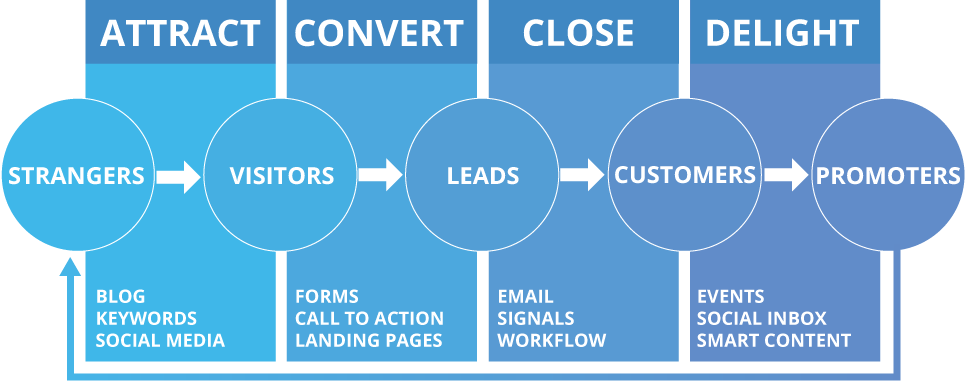When I talk to clients about digital marketing strategy, I like to refer to the inbound marketing methodology, because I think it makes it really clear what we need to do and why we need do it.
At Web Ascender, anything we do as part of a digital marketing strategy, we do with one of the following goals in mind:
- Increasing traffic (visitors) to the website
- Generating leads from website visitors
- Nurturing leads and closing them into customers
- Leveraging customers for referral business, testimonials, etc.
You can see how each of these fits into a larger digital marketing strategy in the graphic below.
The mistake a lot of marketers I speak with make is thinking that one of these tactics or focus areas can be successful independent of the others. So if there’s one thing you take away from this blog post, let it be this:
Traffic to your website doesn’t mean a thing if those visitors aren’t turning into leads, and website leads are useless if you don’t have a process in place to turn them into customers.
A comprehensive digital marketing strategy takes each piece into account and actively works to move potential buyers through the process — SEO, social media and search or social ads drive traffic, calls to action and landing pages generate leads and targeted emails, workflows and remarketing help nurture leads into customers, but doing one or two without the others isn’t a strategy. It’s simply implementing tactics.
Now that we have an idea of what a digital marketing strategy looks like, let’s talk about how marketing automation fits into it.
What is marketing automation?
With traditional email marketing, you might send out a newsletter once a month or once a quarter. You might send promotional emails here and there. You might even have an automated email to notify your list whenever a new blog post is published on your website.
These are all good ways to stay at the forefront of the minds of your contacts. But there’s one thing missing: Personalization. These types of emails don’t account for the fact that everyone on your list is different. They’re all at different points in their buying cycle or customer lifecycle, which means they don’t all need the same content at the same time.
Marketing automation takes email marketing to the next level. It goes beyond the standard newsletters and RSS emails and caters to where your contacts are at any given point in time. This is essential to the customer-centric marketing required by the way we buy things today.
Want to take your email marketing to the next level with marketing automation? Click to download the Marketing Automation Checklist.
What role does marketing automation play?
With this definition of marketing automation in mind, let’s take a look at some actual examples you can put in place to personalize your messaging with contacts and give them the extra push to take the action you’re looking for.
Nurturing leads
A primary role that marketing automation plays relates to nurturing leads. Any easy way to think of lead nurturing is by thinking about moving a prospect through a flow or funnel that is usually completed for someone to become a customer.
A typical buyer’s journey will consist of an Awareness stage, where the buyer has a problem or a question they are trying to identify. This is followed by a Consideration stage where possible solutions are researched and thought through. Finally, a buyer will come to a Decision stage, where he will evaluate actual products or services providers that offer his preferred solution.
Just because this buying cycle exists does not mean that every new visitor to your website or lead is at the same stage when they first identify themselves.
Marketing automation allows businesses to nurture prospective customers by using signals identify where they are in the buying cycle when they become a lead. You can then hit the lead with targeted email content aimed at moving them from one stage to the next.
Up-selling and cross-selling
In addition to nurturing leads, marketing automation can also be used to up-sell or cross-sell once a lead becomes a customer.
Using signals around what was purchased and when, you can set up emails to be automatically triggered that welcome the customer, provide useful tips on getting started or using the product and promote supplemental products or services that might be of interest.
Contact re-engagement
Another role of marketing automation can be to re-engage a stale list. Set up a drip campaign to automatically enroll contacts who haven’t been to your website in 3 months or haven’t opened an email in a while.
Some good ways to re-engage these contacts include a coupon, discount or offer or even a “break up” email, asking if they want to stay on your list.
Evangelist nurturing
A final example of the role marketing automation plays relates not to selling to these contacts, but collecting information to help you sell to others. When it comes to digital marketing strategy, an “Evangelist” is typically a contact who is highly engaged with your brand and absolutely loves your product or service. With marketing automation, you can put triggers in place to identify these contacts, and then send them a series of emails asking them to rate a product they bought, submit a testimonial about your service or recommend people in their network they think would be a good fit for what you offer.
Getting started with marketing automation
These are just the beginning of ways that marketing automation can play a role in your larger digital marketing strategy.


